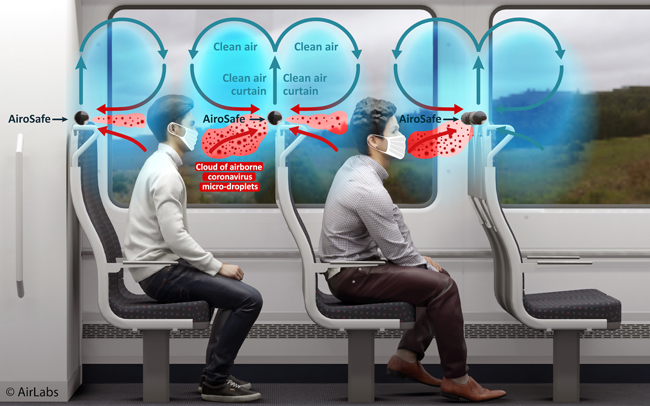Marc Ottolini, CEO of AirLabs, sets out the potential for air cleaning technology to solve the public transport crisis caused by COVID-19.
The public transport industry is under strain. The global lockdowns at the start of the COVID-19 crisis led to a staggering 90% drop in revenue and the recovery has been sluggish, with revenues still down by almost half and not expected to return to normal until 2024 at the earliest.
Public transport providers have played a valiant role in supporting our economies and helping commuters into work during the pandemic, often running increased services despite significantly reduced passenger numbers due to social distancing.
But they cannot continue to do that forever. Already we have seen a number of providers warn that their businesses are under serious threat, which will only get worse the longer the pandemic continues.
Customer confidence is at an all-time low and recent research has shown that 70% of Londoners no longer feel comfortable with the idea of commuting to work via public transport, so how can we make public transport COVID-safe and persuade the public to get back on board?
Airborne coronavirus
To reduce the risk of catching coronavirus we must first understand how it is spread.
Everyone is now familiar with three of the key prevention methods – washing your hands, wearing a mask and maintaining social distance. These measures avoid people catching the virus by transmission from surfaces and from droplets, which can occur when in close contact to others.
However, there is a third, less well-known way of transmitting the virus, which is via aerosols – small particles that we transmit when we breathe out, talk, sneeze, laugh or cough.
Imagine them as the clouds of steam that you breathe out on a cold day. You will notice that the cloud is most concentrated nearest to you but can travel significant distances before dispersing.
Leading scientists have been campaigning for more attention to be paid to the airborne route of transmission throughout the year and the World Health Organisation and the US Centers for Disease Control and Prevention (CDC) have since acknowledged that coronavirus can be spread via airborne transmission.
Social distancing can help to protect the public from this invisible threat; however, evidence shows that coronavirus particles can remain live and suspended in the air for up to three hours in enclosed spaces.
Masks are effective at containing larger droplets, but studies have shown they can allow as much as 70% of infected aerosols to pass.
This means that on public transport one infected passenger could potentially contaminate the whole vehicle.
The role of technology
Ventilation is at the heart of the solution for airborne coronavirus but in a transport setting can prove challenging.
Weather and customer comfort make opening windows a challenge and vehicle ventilation and air conditioning systems can be more dangerous by re-distributing contaminated air throughout the vehicle.
The key is to be able to efficiently filter the air of airborne pathogens and deliver enough clean air to create a “clean air zone” for passengers and drivers.
Our AirBubbl in-vehicle air cleaning device does just that and is already being used to protect bus drivers in Europe and the US in addition to being used in private hire and patient transport vehicles dealing with the pandemic.
The device, which is roughly the size of a Bluetooth speaker, removes more than 95% of airborne viruses and contaminated particulate matter and floods the space with over 30,000 litres of clean air every hour to keep drivers and passengers safe.
AiroSafe
The AirBubbl is the perfect device for small spaces, however the passenger cabins of public transportation provide a different challenge.

Illustration of how AiroSafe should work
That’s why we’ve developed the AiroSafe, which is specifically designed to remove airborne viruses and contaminated particles from the passenger cabins of public transportation, including buses, coaches and trains. It does that by providing each passenger with a personal clean air zone at their seat.
A single person exhales eight litres of air per minute, while the AiroSafe filters an impressive 600 litres of air in the same time ensuring that every passenger seat is flooded with clean air.
Like the AirBubbl, the device filters more than 95% of airborne viruses and contaminated particles, as well as other harmful pollutants including PM2.5, PM10, nitrogen dioxide and ozone, which are known to cause heart, lung and other diseases. This means that it will keep passengers safe even after the threat of coronavirus has passed.
The cost per installation is low, as running costs are recouped with just one ticket sale and the per installation cost return on investment can be achieved within a very short time.
Getting public transport back on track
At AirLabs we fully understand the crisis that the industry faces. It is only by embracing this new technology that public transport providers will be able to confront this challenge and see passenger numbers and revenues return to pre-COVID levels.
Register now for full access
Register just once to get unrestricted, real-time coverage of the issues and challenges facing UK transport and highways engineers.
Full website content includes the latest news, exclusive commentary from leading industry figures and detailed topical analysis of the highways, transportation, environment and place-shaping sectors.
Use the link below to register your details for full, free access.
Already a registered? Login